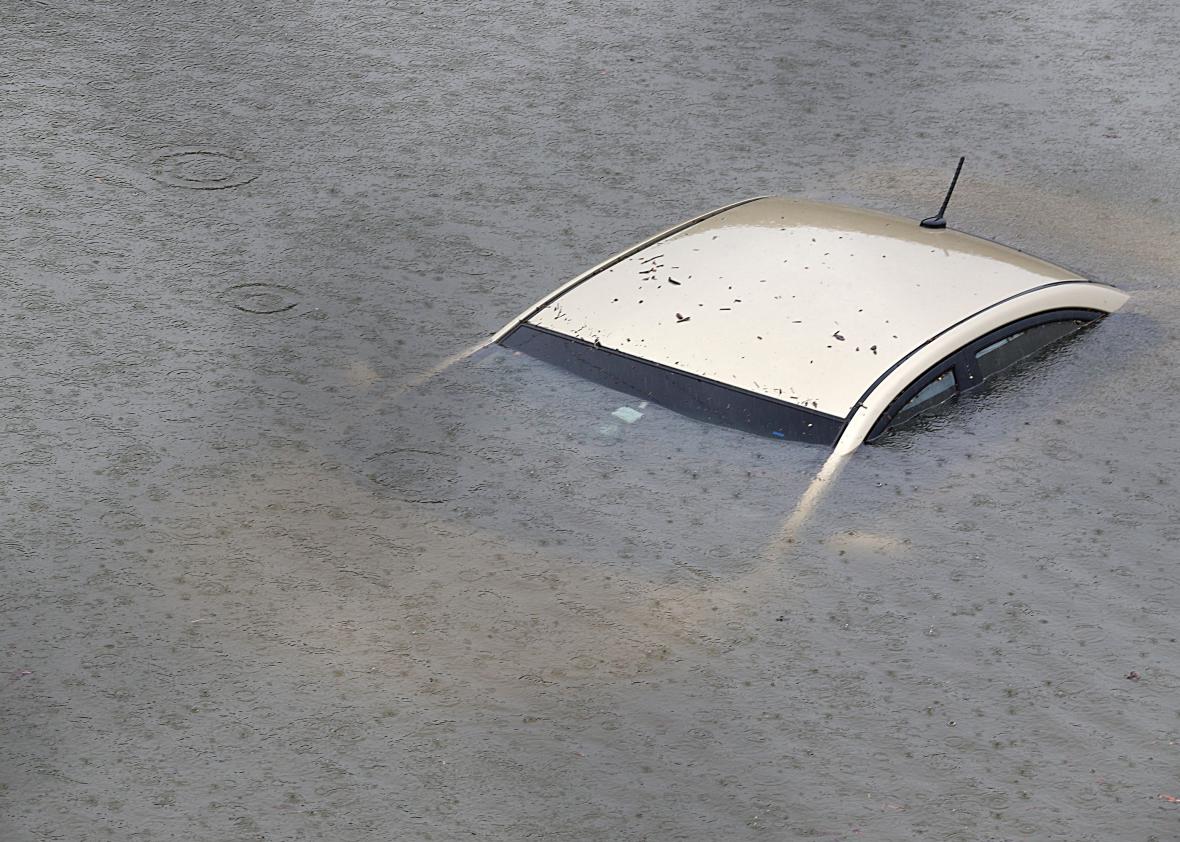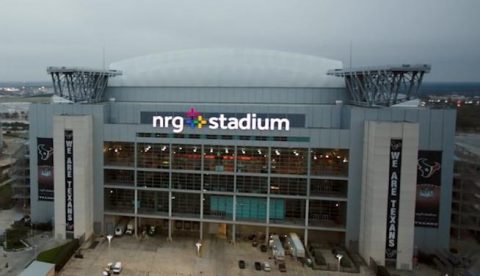
First, the good news to my many friends and readers: I made it through Hurricane Harvey with just about everything intact. Where I am, the house took on only a small amount of water, and the most difficult part of the cleanup will probably be the wood chips and twigs deposited by the flood waters.
I have been watching the non-stop news coverage off and on, flipping between KPRC (channel 2), KTRK (channel 13), and KRIV (channel 26). (For some reason I have yet to figure out, I’m only intermittently able to pick up KHOU (channel 11) now. The last time I tried I could not get a usable picture, and I have a good antenna now (as opposed to the questionable antenna I was making do with for a while). The most recent weather reports I’m seeing suggest we might get a few more showers, but it’s an amount of rain measured in fractions of an inch versus measured in feet.
The National Weather Service tweeted this:
which is basically throwing their hands up in the air and saying “we’ve never seen this before.” In fact, the NWS had to adjust the coloring of their online rainfall maps, changing the previous dark purple that used to indicate merely “over 15 inches” now indicates “15 to 20 inches” with two new lighter shades of purple for “20 to 30 inches” and “over 30 inches”. The NWS spokesperson was quoted as saying this amount of rainfall was “literally and figuratively off the map”.
Per the Wikipedia article, the official totals at Bush Intercontinental Airport (which, by the way, is closed as I write this, but may be reopened by the time I actually post it) were 14.4 inches and 16.08 inches for August 26 and 27 respectively. That’s a combined two-day total of 30.48 inches. The average annual rainfall–and I emphasize that word for a reason–is 49.77 inches. That’s around 7 to 7½ months’ worth of rain in two days, with maybe another one or two inches of rain to come.
(Incidentally, this WGN story refers to the apparent official record for a one-day rainfall total of some 43 inches, caused by Tropical Storm Claudette in Alvin, Texas, back in 1979. From the same story, the worldwide one-day record is a staggering 73.62 inches, or just over 6 feet, which hit Reunion Island east of Madagascar in 1952.)
For obvious reasons, this weather event caught attention at the national and international level. Slate recently published a story about the preparedness of the Houston area for Harvey and future storms, and Quartz published a story which basically condemns the urban sprawl style of development that the Houston area is now known for. It is these stories that I want to focus on in this post, as I would like to see Hurricane Harvey be the last storm to affect our area in such a catastrophic fashion.
The most important takeaways from the Slate article are the reasons Houston was not evacuated. When people evacuated from Hurricane Rita in 2005, the death toll from the evacuation (over 100!) was worse than the death toll from the actual storm itself. (I stayed put for Rita, which made landfall near Orange, Texas, putting Houston on the “clean” side of the storm. There was no major damage in the part of west Houston I was staying in at the time; the most visible effects were a lot of traffic lights and signs being blown out of position, and some minor debris being blown onto the roads.) Given that that storm came on the heels of Hurricane Katrina earlier that year, people were a bit more on edge. However, New Orleans is a much smaller city than Houston, and Mayor Sylvester Turner is spot on in saying “you can’t put… 2.4 million people on the road [evacuating Houston]”.
This brings up the first point I’d like to make. Since the disaster that was the evacuation from Rita, improvements were made by the local authorities, with freeways such as I-45 having semi-permanent contraflow or “evaculane” capabilities at certain points. These haven’t been tested yet. If Mayor Turner is right, though, and our highways lack the capacity to evacuate the entire city in a reasonable amount of time, this is a problem that needs to be fixed. We need to look at the possibility that Houston has simply grown to be too big, at least in population.
If only population was the only issue. The Quartz article features a dramatic before-and-after sliding picture showing the difference in natural wetlands versus developed land between 1986 and 2017. The science doesn’t lie: keeping wetlands in their natural state is one of the best ways of mitigating flood damage. Houston’s lack of zoning laws, the willingness of developers to pave over wetlands, and the lack of a legal way for the government to stop them and the ever-increasing urban sprawl, have resulted in what we have today in 2017.
Back in the 1950s when my grandparents moved to this area, I-610 (“the Loop”) was essentially the city limits, with the house they bought being maybe a mile or so north of that highway. Then, Beltway 8 was built, first as a normal surface road, then a controlled-access toll road. Now, most recently, Texas 99 or the Grand Parkway was built, which actually goes into neighboring counties.
A lot of the opposition to the Grand Parkway was that it is a “road to nowhere”. Well, so was Beltway 8 when it was first built. So was I-610 when it was first built. It’s a chicken-and-egg problem: developers won’t build where there are no roads, so when roads are first being built they appear to be useless “roads to nowhere”. Yet, the Grand Parkway can be seen as a symptom of the disease that is urban sprawl.
Yet more frightening is this quote from the Quartz article:
Obama had greatly expanded the number of wetlands protected by the Clean Water Act. This federal law requires developers who destroy wetlands to mitigate the ecological effects, for instance by creating new wetlands elsewhere. In February, the Trump administration said it would repeal (paywall) Obama’s decision, meaning a lot more wetlands would lose that protection. (The repeal process is still unfolding.)
Not that Houston has ever been a stickler for federal rules. To get a permit under the Clean Water Act, developers who build in protected wetland areas must submit paperwork showing they’ve completed mitigation measures. In 2015, Texas A&M and non-profit research group HARC analyzed a sample of permits issued from 1990 to 2012 in the greater Houston area. They found that in fewer than half of the cases had the developers submitted complete paperwork, and in two thirds of the cases, there was no documentation that any type of mitigation had happened. Another study (pdf) by the same two groups looked at a dozen projects that had obtained permits, and found that only two of them had successfully offset wetland destruction, seven were partially successful, and three were complete failures.
Given his track record, it’s not the least bit surprising that DJT plans to repeal this law passed by his predecessor. However, a lot of the blame has to be placed on the governments granting permits in the Houston area without proper regard to the Clean Water Act. It is inexcusable that fewer than half of the projects had the required documentation, and it is definitely inexcusable that those responsible for granting the permits overlooked this. Continuing on:
And that’s only projects subject to federal regulations. The researchers found that the vast majority of wetland-disrupting activities aren’t subject to those rules. “The inevitable resultant freshwater wetland loss is therefore often uncounted and unmitigated,” they wrote (pdf).
In other words, there are some cases where developers can build on or otherwise disrupt wetlands and there is no oversight from the government.
The Slate article touches on this too:
One underlying cause of Houston’s suffering is that developers and town officials in Harris County, which contains Houston, have for years advocated the development of the wetlands and prairies around the city—land that had long served to absorb the rainwater that now overwhelms the region’s sewers and streams every year. The flood-absorbent grasslands of the Katy Prairie have been cut by three-quarters over the past few decades as Houston sprawled west. The state played along, funding expansion of I-10, “the Katy Freeway,” and another road, the Grand Parkway, which further opened that land up for development. To make matters worse, money-hungry officials also encouraged development in low-lying, flood-prone areas without regard to future risk. There have been more than 7,000 units built in the hundred-year floodplain since 2010, according to a ProPublica/Texas Tribune analysis. Efforts to reform the city’s building codes have been met with strong resistance in an area where homebuilding has been a major economic engine.
Or, put another way: to hell with the future potential for flooding, the homebuilders and developers need to make money. Profits come before people. The home builders build a house, and once it’s sold, they don’t care if it floods, they’ve been paid and that’s now the new homeowner’s problem (and possibly the bank’s problem). It should be obvious that this is unsustainable. It’s going to take a radical shift in how we view our city, but it is obvious we can fix this into a more sustainable model.
The first step is that a significant portion of the paved-over wetlands and prairie need to be returned to their natural state. I’m not sure exactly how much, but I would say at least a third of what has been developed since 1986 at a bare minimum, but more likely at least half. The only way I see to do this is for the government to buy back houses and buildings built in these areas, using eminent domain if necessary. The people and businesses displaced will need to relocate into other areas, possibly further out from the center of Houston to preserve the wetlands and prairie. The properties that keep getting flooded the worst would be the highest priority. A lot of the problem, by the way, is not in the city of Houston proper, but out in the suburbs surrounding Houston. If we can fix this through zoning (real zoning, not just deed restrictions), then we would need a zoning authority that covered at minimum the counties of Harris, Fort Bend, Montgomery, Waller, Liberty, Brazoria, and at least the mainland portion of Galveston County. I’m not sure what to do about cities with existing zoning regulations (I know of Tiki Island and Jersey Village, there may be others). If zoning is not the answer, we need some way to stop developers and say “no, you can’t build here, it will make flooding worse”. Yes, it’s going to be expensive to turn a lot of the built-up areas back to wetlands, prairie, and other natural states, but we would spend even more money cleaning up flood after flood after flood. A lot of the land should have stayed in its natural state (wetlands or prairie) to begin with.
The second step is that we must more closely follow the settlement patterns of other cities of comparable and larger size: namely higher-density development with an emphasis on pedestrian- and transit-friendly attributes. I would eventually like to see I-10, I-69, I-45, and US 290 rebuilt as narrower freeways with the excess land used for commuter rail. As for the Grand Parkway, parts of it have been built, so I’m torn between saying we may as well finish it, and the rest of it shouldn’t be built; if it is completed, particular attention needs to be paid to the environmental impacts of doing so. If this sounds crazy or like a pipe dream to you, take a look at pictures of Houston and how ridiculously big the Katy Freeway (I-10 west of downtown) and Southwest Freeway (I-69/US 59 southwest of downtown) are. Then look at the largest freeways in cities around the world. No other city in the world makes their freeways with this many lanes for miles and miles. Look at New York City with its subways and Chicago with its “el” trains. (I realize we can’t do subways in Houston, but we definitely can do better with public transit. To its credit, the reimagined bus route network from Metro is a huge improvement, but there still exists plenty of room for improvement.) Worse, we are now calling on Metro to spend money out of its budget for fixing roads, which is completely ass-backwards. Metro’s money should go for public transit and HOV lane operation. We should not be dipping into that to fix roads for cars at the expense of public transit.
The third step is that every developer needs to ask the questions “what happens when it floods?” and “if we build this, will it flood elsewhere?” Notice I don’t word that first one as “what happens if it floods?” because we know it’s going to flood at some point. For a long time, those in charge of building new homes and buildings have worried more about getting paid than flooding. I understand the need to stay in business, but past a certain point, building on previous wetlands and building too close to a reservoir (I forget where I read this, but it was described as effectively the same as “building homes in a lake”) is going to backfire and get somebody all wet.
Another thing is we have to lose this attitude that we can just build more roads to fix our traffic problems. More concrete is not the answer. I know everyone appreciates the convenience of not having to ride the bus back out to the park & ride lot to get the car at the end of the day, but for the same reason we can’t put a million cars on the road to evacuate from a hurricane, we can’t realistically expect that everyone can drive their car to work, especially when home is 25 or more miles from work.
Finally, the flood plains need to be redrawn based on the events of the past few years. Climate change has happened, and we no longer can count on the 50-year flood plain to be an area that’s going to flood once every 50 years. Speaking of which, the terminology is misleading. People point out that “50-year flood” really means it has a 2% chance of occurring in a given year. Maybe when meteorology first began being able to measure flood plains, the 50-year figure was truly accurate. They are calling Hurricane/Tropical Storm Harvey a 500-year, 800-year, or 1000-year flood depending on who you talk to. Unfortunately, Tropical Storm Allison only hit in 2001, 16 years ago. Hurricane Ike hit in 2008, then we had the Tax Day and Memorial Day floods in the past couple of years. Obviously, we don’t have data going back that far, but based on my observation, Harvey is maybe a 50-year storm based on the climate we have today. I would be more willing to label it a 25-year storm depending on what happens in the next few years in this area. This is climate change, and this is real. Those who are denying climate change are liars, and the effects of this storm are the proof.
I realize nobody can realistically plan for 30+ inches of rain over two days. There’s no way that is going to happen without some flooding happening somewhere. However, we can plan to reduce the impact of such an event. Urban sprawl and the uncoordinated, idiotic, and scatterbrained pattern of development in the Houston area have gone beyond a mere environmental issue to a public safety issue. We can’t just sit there and let this happen again next time a hurricane or tropical storm hits us.



